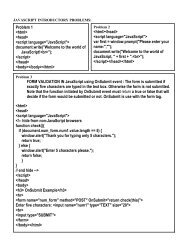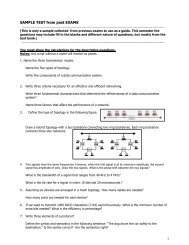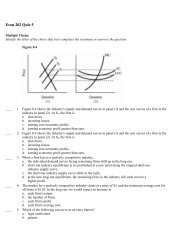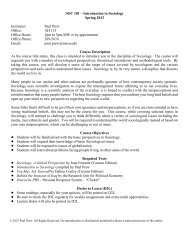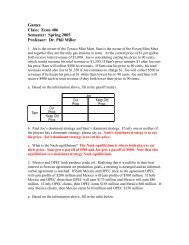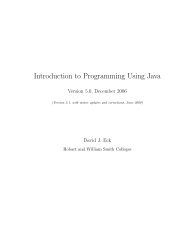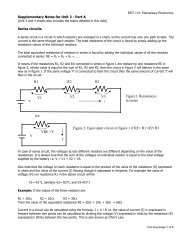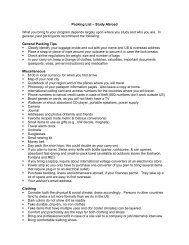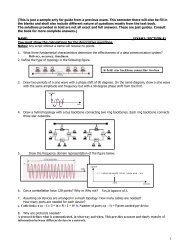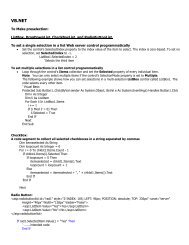Econ 202 Exam 2 Practice Problems - Krypton
Econ 202 Exam 2 Practice Problems - Krypton
Econ 202 Exam 2 Practice Problems - Krypton
You also want an ePaper? Increase the reach of your titles
YUMPU automatically turns print PDFs into web optimized ePapers that Google loves.
<strong>Econ</strong> <strong>202</strong> <strong>Exam</strong> 2 <strong>Practice</strong> <strong>Problems</strong><br />
Principles of Microeconomics<br />
Dr. Phillip Miller<br />
Multiple Choice<br />
Identify the choice that best completes the statement or answers the question.<br />
Chapter 6<br />
____ 1. If a binding price ceiling is imposed on the computer market, then<br />
a. the quantity of computers demanded will increase.<br />
b. the quantity of computers supplied will decrease.<br />
c. a shortage of computers will develop.<br />
d. All of the above are correct.<br />
____ 2. In response to a shortage caused by the imposition of a binding price ceiling on a market,<br />
a. price will no longer be the mechanism that rations scarce resources.<br />
b. long lines of buyers may develop.<br />
c. sellers could ration the good or service according to their own personal biases.<br />
d. All of the above are correct.<br />
____ 3. As rationing mechanisms, prices<br />
a. and long lines are efficient.<br />
b. are efficient, but long lines are inefficient.<br />
c. are inefficient, but long lines are efficient.<br />
d. and long lines are inefficient.<br />
____ 4. A tax imposed on the sellers of a good will<br />
a. raise both the price buyers pay and the effective price sellers receive.<br />
b. raise the price buyers pay and lower the effective price sellers receive.<br />
c. lower the price buyers pay and raise the effective price sellers receive.<br />
d. lower both the price buyers pay and the effective price sellers receive.<br />
Figure 6-9
10<br />
9<br />
8<br />
7<br />
6<br />
5<br />
4<br />
3<br />
2<br />
1<br />
price<br />
D<br />
D after tax<br />
S<br />
10 20 30 40 50 60 70 80 quantity<br />
____ 5. Refer to Figure 6-9. Suppose the same supply and demand curves apply and a tax of the same amount per<br />
unit as shown here is imposed. Now, however, the sellers of the good, rather than the buyers, are required to<br />
pay the tax to the government. Now, relative to the case depicted in the figure,<br />
a. the burden on buyers will be larger and the burden on sellers will be smaller.<br />
b. the burden on buyers will be smaller and the burden on sellers will be larger.<br />
c. the burden on buyers will be the same and the burden on sellers will be the same.<br />
d. The relative burdens in the two cases cannot be determined without further information.<br />
____ 6. If a tax is imposed on a market with inelastic demand and elastic supply, then<br />
a. buyers will bear most of the burden of the tax.<br />
b. sellers will bear most of the burden of the tax.<br />
c. the burden of the tax will be shared equally between buyers and sellers.<br />
d. it is impossible to determine how the burden of the tax will be shared.<br />
Chapter 7<br />
Table 7-1<br />
Buyer Willingness To Pay<br />
Mike $50.00<br />
Sandy $30.00<br />
Jonathan $20.00<br />
Haley $10.00<br />
____ 7. Refer to Table 7-1. If the price of the product is $51, then who would be willing to purchase the product?<br />
a. Mike<br />
b. Mike and Sandy<br />
c. Mike, Sandy, and Jonathan<br />
d. no one<br />
____ 8. Refer to Table 7-1. If the price of the product is $18, then the total consumer surplus is<br />
a. $38.<br />
b. $42.<br />
c. $46.<br />
d. $72.
Table 7-5<br />
For each of three potential buyers of oranges, the table displays the willingness to pay for the first three<br />
oranges of the day. Assume Alex, Barb, and Carlos are the only three buyers of oranges, and only three<br />
oranges can be supplied per day.<br />
First Orange Second Orange Third Orange<br />
Alex $2.00 $1.50 $0.75<br />
Barb $1.50 $1.00 $0.80<br />
Carlos $0.75 $0.25 $0<br />
____ 9. Refer to Table 7-5. If the market price of an orange is $0.40,<br />
a. 6 oranges are demanded per day, and total consumer surplus amounts to $4.45.<br />
b. 6 oranges are demanded per day, and total consumer surplus amounts to $5.10.<br />
c. 7 oranges are demanded per day, and total consumer surplus amounts to $5.35.<br />
d. 7 oranges are demanded per day, and total consumer surplus amounts to $5.50.<br />
____ 10. Suppose Lauren, Leslie and Lydia all purchase bulletin boards for their rooms for $15 each. Lauren's<br />
willingness to pay was $35, Leslie's willingness to pay was $25, and Lydia's willingness to pay was $30.<br />
Total consumer surplus for these three would be<br />
a. $15.<br />
b. $30.<br />
c. $45.<br />
d. $90.<br />
____ 11. Ally mows lawns for a living. Ally’s out-of-pocket expenses (for equipment, gasoline, and so on) plus the<br />
value that she places on her own time amount to her<br />
a. producer surplus.<br />
b. producer deficit.<br />
c. cost of mowing lawns.<br />
d. profit.<br />
____ 12. Producer surplus is the<br />
a. area under the supply curve to the left of the amount sold.<br />
b. amount a seller is paid minus the cost of production.<br />
c. area between the supply and demand curves, above the equilibrium price.<br />
d. cost to sellers of participating in a market.<br />
____ 13. At present, the maximum legal price for a human kidney is $0. The price of $0 maximizes<br />
a. consumer surplus but not producer surplus.<br />
b. producer surplus but not consumer surplus.<br />
c. both consumer and producer surplus.<br />
d. neither consumer nor producer surplus.<br />
____ 14. A simultaneous increase in both the demand for MP3 players and the supply of MP3 players would imply that<br />
a. both the value of MP3 players to consumers and the cost of producing MP3 players has<br />
increased.<br />
b. both the value of MP3 players to consumers and the cost of producing MP3 players has<br />
decreased.<br />
c. the value of MP3 players to consumers has decreased, and the cost of producing MP3<br />
players has increased.<br />
d. the value of MP3 players to consumers has increased, and the cost of producing MP3<br />
players has decreased.
Chapter 8<br />
____ 15. If a tax shifts the supply curve downward (or to the right), we can infer that the tax was levied on<br />
a. buyers of the good.<br />
b. sellers of the good.<br />
c. both buyers and sellers of the good.<br />
d. We cannot infer anything because the shift described is not consistent with a tax.<br />
____ 16. If T represents the size of the tax on a good and Q represents the quantity of the good that is sold, total tax<br />
revenue received by government can be expressed as<br />
a. T/Q.<br />
b. T+Q.<br />
c. TxQ.<br />
d. (TxQ)/Q.<br />
____ 17. For good B, the supply curve is the typical upward-sloping straight line, and the demand curve is the typical<br />
downward-sloping straight line. When good B is taxed, the area on the relevant supply-and-demand graph<br />
that represents<br />
a. government’s tax revenue is a rectangle.<br />
b. the deadweight loss of the tax is a triangle.<br />
c. the loss of consumer surplus caused by the tax is neither a rectangle nor a triangle.<br />
d. All of the above are correct.<br />
____ 18. In the market for widgets, the supply curve is the typical upward-sloping straight line, and the demand curve<br />
is the typical downward-sloping straight line. The equilibrium quantity in the market for widgets is 200 per<br />
month when there is no tax. Then a tax of $5 per widget is imposed. As a result, the government is able to<br />
raise $750 per month in tax revenue. We can conclude that the equilibrium quantity of widgets has fallen by<br />
a. 25 per month.<br />
b. 50 per month.<br />
c. 75 per month.<br />
d. 100 per month.<br />
____ 19. Suppose that the government imposes a tax on dairy products. The deadweight loss from this tax will likely<br />
be greater in the<br />
a. first year after it is imposed than in the fifth year after it is imposed because demand and<br />
supply will be more elastic in the first year than in the fifth year.<br />
b. first year after it is imposed than in the fifth year after it is imposed because demand and<br />
supply will be less elastic in the first year than in the fifth year.<br />
c. fifth year after it is imposed than in the first year after it is imposed because demand and<br />
supply will be more elastic in the first year than in the fifth year.<br />
d. fifth year after it is imposed than in the first year after it is imposed because demand and<br />
supply will be less elastic in the first year than in the fifth year.<br />
____ 20. The amount of deadweight loss that results from a tax of a given size is determined by<br />
a. whether the tax is levied on buyers or sellers.<br />
b. the number of buyers in the market relative to the number of sellers.<br />
c. the price elasticities of demand and supply.<br />
d. the ratio of the tax per unit to the effective price received by sellers.<br />
Chapter 10<br />
Note: The practice problems for chapters 9 and 11 follow the practice problems for chapter 10
____ 21. Market failure can be caused by<br />
a. too much competition.<br />
b. externalities.<br />
c. low consumer demand.<br />
d. scarcity.<br />
____ 22. An externality arises when a person engages in an activity that influences the well-being of<br />
a. buyers in the market for that activity and yet neither pays nor receives any compensation<br />
for that effect.<br />
b. sellers in the market for that activity and yet neither pays nor receives any compensation<br />
for that effect.<br />
c. bystanders in the market for that activity and yet neither pays nor receives any<br />
compensation for that effect.<br />
d. Both (a) and (b) are correct.<br />
____ 23. Suppose that elementary education creates a positive externality. If the government does not subsidize<br />
education, then<br />
a. the equilibrium quantity of education will be equal the socially optimal quantity of<br />
education.<br />
b. the equilibrium quantity of education will be greater than the socially optimal quantity of<br />
education.<br />
c. the equilibrium quantity of education will be less than the socially optimal quantity of<br />
education.<br />
d. There is not enough information to answer the question.<br />
Figure 10-9<br />
P1<br />
Price<br />
Panel (a)<br />
Q1<br />
Supply<br />
Demand<br />
Quantity
P3a<br />
P2<br />
P3b<br />
Price<br />
Panel (b)<br />
Q2<br />
Q3<br />
Social cost<br />
Supply<br />
Demand<br />
Quantity<br />
Panel (c)<br />
____ 24. Refer to Figure 10-9, Panel (c). The market equilibrium quantity is<br />
a. Q4, which is the socially optimal quantity.<br />
b. Q5, which is the socially optimal quantity.<br />
c. Q4, and the socially optimal quantity is Q5.<br />
d. Q5, and the socially optimal quantity is Q4.<br />
P4a<br />
P5<br />
P4b<br />
Price<br />
Q4 Q5<br />
Supply<br />
Demand<br />
Social value<br />
Quantity
Chapter 11<br />
____ 25. Which of the following is an advantage of tradable pollution permits?<br />
a. Each firm is allowed to pollute exactly the same amount.<br />
b. Revenue from the sale of permits is greater than revenue from a corrective tax.<br />
c. The initial allocation of permits to firms does not affect the efficiency of the market.<br />
d. Firms will engage in joint research efforts to reduce pollution.<br />
____ 26. Bill owns 3 acres of beautiful wooded land. When Bill decides to move to be closer to his grandchildren, he<br />
donates the land to the state with the understanding that the land will be used as a state park. This state park is<br />
large enough that it is not congested. It is an example of a good that is<br />
a. both rival in consumption and excludable.<br />
b. neither rival in consumption nor excludable.<br />
c. nonrival in consumption and excludable.<br />
d. rival in consumption and nonexcludable.<br />
Table 11-1<br />
Consider the town of Tritown with only three residents, Ed, Jim, and Tony. The three residents are trying to<br />
determine how large, in acres, they should build the public park. The table below shows each resident’s<br />
willingness to pay for each acre of the park.<br />
Acres Ed Jim Tony<br />
1 $12 $16 $28<br />
2 8 12 24<br />
3 4 8 20<br />
4 2 4 16<br />
5 0 1 12<br />
6 0 0 8<br />
7 0 0 4<br />
____ 27. Refer to Table 11-1. Suppose the cost to build the park is $30 per acre and that the residents have agreed to<br />
split the cost of building the park equally. If the residents vote to determine the size of park to build, basing<br />
their decision solely on their own willingness to pay (and trying to maximize their own surplus), what is the<br />
largest park size for which the majority of residents would vote “yes?”<br />
a. 0 acres<br />
b. 1 acre<br />
c. 2 acres<br />
d. 3 acres<br />
____ 28. If the government decides to build a new highway, the first step would be to conduct a study to determine the<br />
value of the project. The study is called a<br />
a. fiscal analysis.<br />
b. monetary analysis.<br />
c. welfare analysis.<br />
d. cost-benefit analysis.
____ 29. Four roommates share an off-campus house and equally share the cost of rent. Everyone says that she values a<br />
clean house, yet the house is usually dirty. To an economist, a clean house in this case represents<br />
a. a common resource problem.<br />
b. a public good.<br />
c. a natural monopoly.<br />
d. All of the above are correct.<br />
Chapter 9<br />
Figure 9-8. On the diagram below, Q represents the quantity of cars and P represents the price of cars.<br />
____ 30. Refer to Figure 9-8. The price corresponding to the horizontal dotted line on the graph represents the price of<br />
cars<br />
a. after trade is allowed.<br />
b. before trade is allowed.<br />
c. that maximizes total surplus when trade is allowed.<br />
d. that minimizes the well-being of domestic car producers when trade is allowed.<br />
____ 31. Refer to Figure 9-8. The country for which the figure is drawn<br />
a. has a comparative advantage relative to other countries in the production of cars and it will<br />
export cars.<br />
b. has a comparative advantage relative to other countries in the production of cars and it will<br />
import cars.<br />
c. has a comparative disadvantage relative to other countries in the production of cars and it<br />
will export cars.<br />
d. has a comparative disadvantage relative to other countries in the production of cars and it<br />
will import cars.<br />
____ 32. Refer to Figure 9-8. When the country for which the figure is drawn allows international trade in cars,<br />
a. consumer surplus increases by the area B.<br />
b. producer surplus decreases by the area B + D.<br />
c. total surplus increases by the area D.<br />
d. All of the above are correct.
____ 33. Refer to Figure 9-8. In the country for which the figure is drawn, total surplus with international trade in cars<br />
a. is represented by the area A + B + C.<br />
b. is represented by the area A + B + D.<br />
c. is smaller than producer surplus without international trade in cars.<br />
d. is larger than total surplus without international trade in cars.<br />
Figure 9-18. On the diagram below, Q represents the quantity of peaches and P represents the price of<br />
peaches. The domestic country is Isoland.<br />
P<br />
7<br />
6<br />
5<br />
4<br />
3<br />
2<br />
1<br />
Domestic supply<br />
Domestic demand<br />
10 20 30 40 50 60 Q<br />
____ 34. Refer to Figure 9-18. If Isoland allows international trade and if the world price of peaches is $5, then<br />
a. Isoland has a comparative advantage, relative to other countries, in producing peaches.<br />
b. Isoland will import peaches.<br />
c. consumer surplus with trade exceeds consumer surplus without trade.<br />
d. All of the above are correct.
<strong>Econ</strong> <strong>202</strong> <strong>Exam</strong> 2 <strong>Practice</strong> <strong>Problems</strong><br />
Answer Section<br />
MULTIPLE CHOICE<br />
1. D<br />
2. D<br />
3. B<br />
4. B<br />
5. C<br />
6. A<br />
7. D<br />
8. C<br />
9. D<br />
10. C<br />
11. C<br />
12. B<br />
13. D<br />
14. D<br />
15. D<br />
16. C<br />
17. D<br />
18. B<br />
19. D<br />
20. C<br />
21. B<br />
22. C<br />
23. C<br />
24. C<br />
25. C<br />
26. B<br />
27. C<br />
28. D<br />
29. A<br />
30. B<br />
31. D<br />
32. C<br />
33. D<br />
34. A



